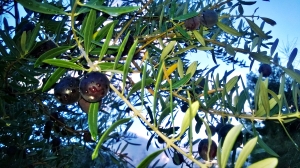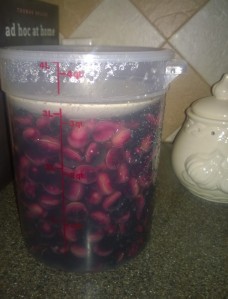I was on an evening walk with my husband, Guy, and we walked past a vacant lot. We’ve walked past that same lot many, many times (and driven by it even more!) and we never noticed the two olive trees in the corner. One of the trees was loaded with olives–dark purple, firm and beautiful. Then it hit me: Why let this beautiful fruit go to waste?
I called my neighbor to see if she knew who owned the lot. I knew that the property used to be owned by a University of California agriculture faculty member who lived across the street from the vacant lot and he used the land for his own personal agricultural “experiments.” UC Riverside is right down the street from my house and its experimental agriculture is a big deal. There are many experimental citrus groves in my neighborhood that are owned and operated by UCR. In fact, the Agricultural Experiment Station at UCR features nearly 1000 acres of open-air laboratories that allow plant scientists to test in real-life conditions everything from how to combat insects and disease to how to increase crop production.
But the small lot with the beautiful olives in my neighborhood had changed hands over the years and I had no idea who to ask about harvesting the olives. And from what I understood, I had a limited time frame. I needed to get the olives off the tree before they softened and shriveled.
My neighbor, Diane, told me that the property had recently been sold to someone who didn’t even live in the neighborhood. They planned to eventually clear all of the interesting plants and trees from the lot and build a home some day.
I went ahead and picked the olives.
Then I had to do a little research. I had no idea what to do with the olives. I knew they had to be cured, but I had no idea how to do it. My research led me to the University of California at Davis’ Olive Center. The UC Davis Olive Center is a self-funded university/industry coalition aimed at meeting the research and education needs of olive growers and processors throughout the world. It’s a cute story how the Olive Center at UC Davis got its start. It’s simple, really.
There are hundreds of olive trees throughout the UC Davis campus. They’re beautiful trees, providing shade and lovely scenery everywhere you look. But, before 2008, the bounty of fruit produced by all these lovely trees was nothing more than a nuisance. The olives would simply ripen and soften on the trees, then drop to the ground in late Fall, creating a mess of black, squishy and slippery goo, which was a hazard along the much-used bike path. Well, the nuisance eventually led to innovation and now UC Davis produces a wide variety of olive oil and olive oil based products. More importantly, the Center’s research and process innovation provides education for olive growers worldwide. Check out this video, “How Bike Safety Helped Create Olive Oil at UC Davis.”
So, I downloaded this wonderful guide that includes everything you ever wanted to know about olives and curing them for good eating. I didn’t realize there were so many ways to cure olives. Lye, salt brine, dry brining, water curing . . . I talked to another friend who has been curing olives for years–he recommended the lye method. I might try that next time, but this time I went with the water curing method. I won’t write it all out here, but check out the guide, Olives: Safe Methods for Home Pickling from UC Davis. I’m using the recipe for Kalamata-style olives and I’m about 4 days in. It’s a long process. It’s going to be about 6 weeks (or longer) before I have edible (and hopefully delicious!) olives. I’ll keep you posted.







How cool! Look forward to seeing how they turn out.
So who is the official brine changer while you are winning the big bucks in FL?
LOL, Lisa! Good question! I JUST asked Guy if he would take care of it for me. He said, “As long as you leave detailed instructions, I can do it.” Seriously, you just need to drain, rinse and refill with water. I’ll make sure Garrett knows what to do, to.
I love this story!! I’m so impressed that you jumped right in to cure your found bounty without any idea how to do it! I’m so loving following this adventure!
Thanks, Lynne! I hope they turn out. I only have one small batch this time. Next time I’ll do more.
Great story. I’ll be over in 6 weeks for the tasting, with bread and wine.
I’ll be ready . . . with cheese!